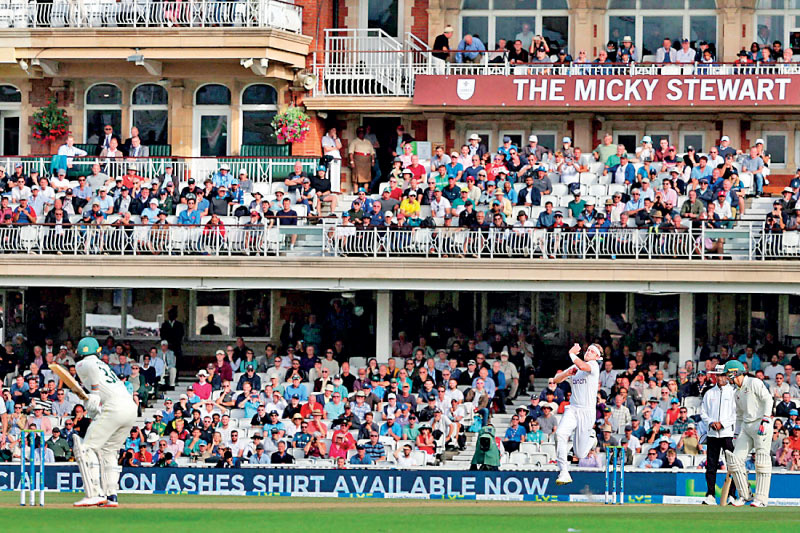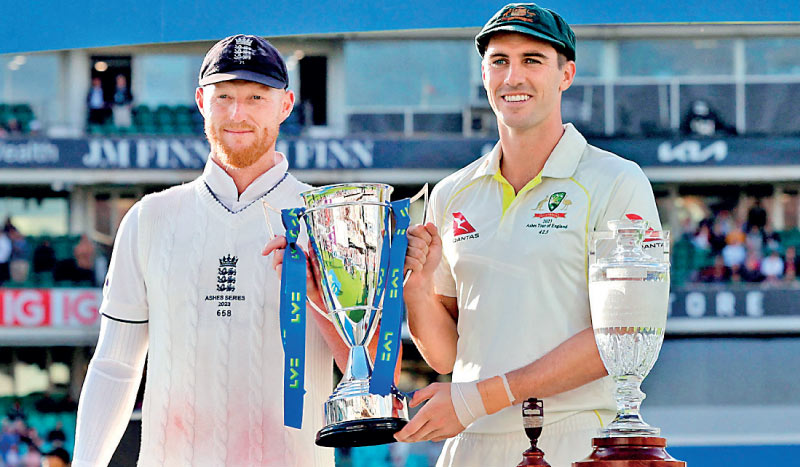Thursday Jan 01, 2026
Thursday Jan 01, 2026
Thursday, 3 August 2023 00:26 - - {{hitsCtrl.values.hits}}

England’s Stuart Broad bowls to Australia’s Todd Murphy on day five of the fifth Ashes cricket Test match between England and Australia at The Oval cricket ground in London on 31 July – AFP

England’s captain Ben Stokes (L) and Australia’s captain Pat Cummins (R) hold the Series trophy after the drawn Ashes Series, after England’s victory on day five of the fifth Ashes cricket Test match between England and Australia at The Oval cricket ground in London on 31 July –AFP
 So, the Ashes 2023, Test cricket’s biggest showcase, ended 2-2. In the end, it was a fair result for two teams playing absorbingly contrasting styles of Test cricket over seven weeks; Australia playing the conventional game, and England responding with their adventurous Bazball in rollicking fashion, defying all norms. The series had pretty much everything; top notch batting and bowling, game-changing performances, thrills and spills, drama, highs, lows and even controversies.
So, the Ashes 2023, Test cricket’s biggest showcase, ended 2-2. In the end, it was a fair result for two teams playing absorbingly contrasting styles of Test cricket over seven weeks; Australia playing the conventional game, and England responding with their adventurous Bazball in rollicking fashion, defying all norms. The series had pretty much everything; top notch batting and bowling, game-changing performances, thrills and spills, drama, highs, lows and even controversies.
From the moment Zak Crawley smashing the first ball at Edgbaston for four right upto Chris Broad finding the outside edge of Alex Carey in the final moments at Oval, this Ashes series produced the most enthralling Test cricket one would ever see. Each session of the 5-match series was virtually a blockbuster.
Australia took the lead 2-0 after two exciting Tests at Edgbaston and Lord’s, but England wrested the upper hand thereafter. They bounced back with a magnificent win at Headingly and were well on their way for a big win in the 4th Test at Old Trafford, but play was reduced to only 30 overs on day 4 with no play being possible on day 5. All England needed was 90 minutes of clear weather to draw the series level 2-2. That would have enabled them to win the Ashes 3-2 in a historic comeback, but luck was not on their side. Then, England finally drew the series level 2-2 in the final Test at Oval with a thrilling 49-run win.
The results of each of the decisive 4 Tests would have gone either way. In fact, England could have won the first 2 Tests as well, if not for a few blunders. They declared controversially on the first day in Edgbaston, collapsed from 188 for 1 and 279 for 4 to 325, wasted the new ball in perfect bowling conditions, dropped catches but then almost pulled off one of the most remarkable heists in the Ashes history at Lord’s.
No doubt, Australia played the entire series out of their skin, but in my view, it was England that stole the show. Bazball worked. Their batsmen blew the Aussies away with the bat. In 150 years of Test cricket, no team has ever scored at more than 4 runs an over against Australia. But England rattled along at 4.74 in the Ashes, which is nearly an extra run per over more than any other side! They averaged 34.35 per wicket, nearly 5 more than Australia. And most astonishingly, Australia was allowed to bowl only 34 maiden overs in the entire series! These are mindboggling stats.
England’s batsmen dominated the game according to their terms. They set the terms and Australia was forced to respond. This is exactly what happens when Bazball works. It is not merely about scoring fast or playing entertaining cricket; it’s actually about playing the game with a positive mind-set. Making the opposition react rather than allowing them to be proactive. It is modern and disruptive! (Corporate leaders, take note!)
When this style is in full flow, there is no pressure with the new ball. Normally, even the best teams play the initial overs cautiously as bowlers settle into a rhythm. Batsmen tend to protect their wickets and look to play a long innings. But Zak Crawley and Ben Duckett will go after bowling from the start. They won’t allow the bowlers to settle. Runs start to flow and the captain is forced to spread the field. When the 4th over commences, there is already a deep square leg and deep backward point!
Run scoring continues even after the fielders scatter, as the batsmen pick ones and twos. Wickets may fall, but the run flow never stops. Every batsman understands that his role is not just to occupy the crease and play a long innings but to make the scoreboard rattle at a hectic pace.
All England batsmen made substantial contributions at some point of the series. Crawley made a huge 189 at Headingly and Stokes an incredible 155 at Lord’s, followed by 80 and 51. Joe Roots made a dominating 118 (not out) and two scores over 80. Harry Brook had 4 scores over 50. He started playing Test cricket just 10 months ago, but already has 11 half-centuries in 12 Tests, averaging 65 with a strike rate of 92. He made run-making look very natural. Then, Jonny Bairstow made three big scores over 78. They all batted defying the orthodoxies, best illustrated by the reverse scoop executed by Root against pace bowlers for six on a few occasions.
No Aussie bowler was allowed to dictate terms to any single batsman. England’s run rate continued to remain well above 5 an over. That way, England did not need to bat the whole day - a good 70 overs was more than enough to put an imposing score.
This has been the strategy adopted by England under Ben Stokes and Coach Brendan McCullum for the past 2 years, and it was no different in the Ashes too. Australia played proper, orthodox cricket, scoring at around 3.2. They would graft, grind and play quality bowling on its merits, build good partnerships and finally have a good score on board. Then the England batsmen would simply gallop 130 runs in a session and go past that total in around 60 overs! Their entire approach was to play positively and put the pressure back on the opposition. And that’s what Bazball means.
It was Chris Woakes and Mark Wood who really rattled the Aussies with their pace, bounce and movement which brought England back into contention. Wood was a revelation at Headingly, bowling one of the fastest spells seen in English conditions for some time. He simply blew away the Aussie tail. Woakes was consistently among the wickets and took important wickets, including the threatening Aussie top order at the Oval. They were the most hostile English bowlers, sharing 33 wickets. They were instrumental in turning England’s fortunes in the Ashes after being picked from the 3rd Test. Then there was aggressive field setting by Stokes. Most of the time, his bowling changes and field setting was all about getting a wicket. There were many examples of that.
England played without the fear of losing. Drawing a Test was taken out of the equation. It didn’t matter if they win or lose. That’s why they declared at 398 for 8 in 78 overs in day 1. Having that mindset enabled England not to let the game drift. They believed that they could win from any situation. It’s all part of Bazeball!
Ashes 2023 is one for the ages. In terms of sheer quality of cricket and the impact on Test cricket, it is right up there with 1981 and 2005.